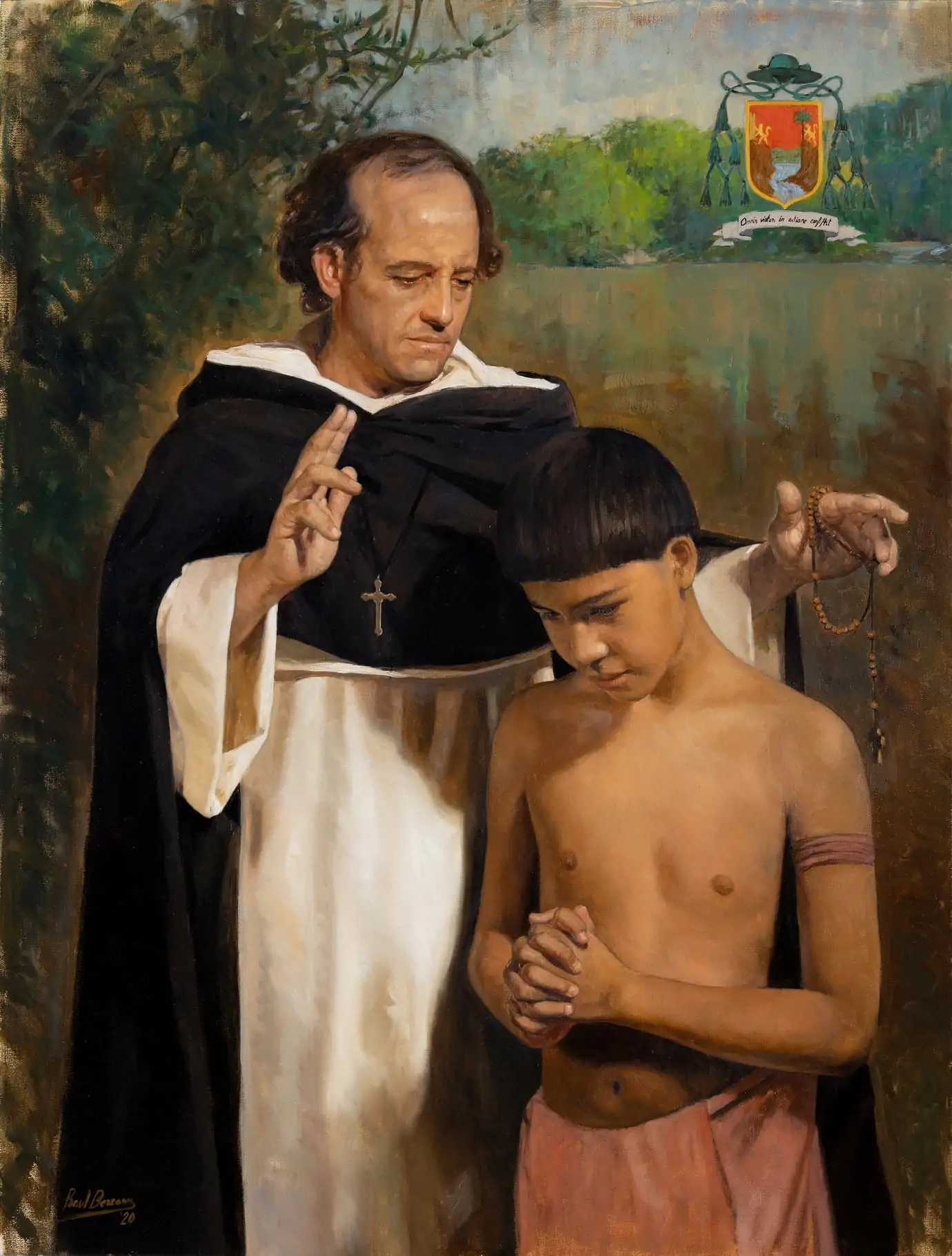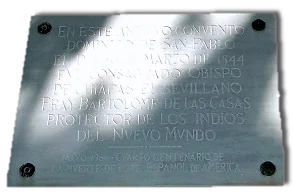A missionary temple
History
Missionary Trainer
The Dominican fathers, with a centuries-old tradition of evangelization and the intellectual training from their centers of General and University Studies, soon felt prepared to evangelize the newly discovered territories.
Thus, from the early 16th century, the Convent of San Pablo el Real gained significant missionary prominence, reaching towards America and the Philippines. This was facilitated by its location in Seville, the gateway and port to America, and its establishment as a General Study in 1504 and a University in 1552, by the bull of Pope Julius III. Within its walls, hundreds of Dominicans either pursued their studies as novices specially trained for missionary action in mission lands or lived for months, awaiting the opportunity to embark on the New World.
The creation of the Dominican Province of Bética or Andalusia in 1514 by Pope Leo X assigned it the territories of Andalusia, the Kingdom of Murcia, La Mancha, half of Extremadura, the Canary Islands, Oran, and the vast regions of the Indies. In 1518, the General Chapter of the Order decreed that the Convent of Santo Domingo de la Española and all the convents and places in the islands discovered in the New World would depend on the provincial prior of the Dominicans of Andalusia, based in San Pablo el Real, further strengthening its American ties.
The Andalusian Province was born with a vocation for America and missions, and the Order entrusted it with the care and governance of all Dominicans going to the Indies. According to Herrera, a 17th-century chronicler, the Dominican Province of Andalusia should be considered the mother of all the provinces that were eventually founded in the Indies because all of them were established in territory that belonged to Andalusia. Thus, it was from the Bética Province that the Gospel would be preached in the newly discovered territories, leading to the expansion of the Order in America, where other provinces such as Santa Cruz de la Indias in 1530 or Santiago de Mexico in 1532 would emerge from the Province of Andalusia.
Some have even seen this unique American connection reflected in certain ornamental elements designed by Leonardo Figueroa in the construction of the current church of the extinct Convent of San Pablo, identifying, among others, the caryatids of the lantern of the dome with Amerindian figures.
The First Missionaries
Cardinal and Archbishop of Seville, Fray García de Loaysa (1480-1546), General of the Order, confessor to Emperor Charles V, and president of the Council of the Indies, was responsible for organizing expeditions to the Canaries and the New World from the royal court. After obtaining the Dominican Order's Royal Decree on February 11, 1509, granting passage to the Indies for fifteen friars and three laypeople, his older brother, Fray Domingo de Mendoza y Loaysa, promoted the first missionary journeys, departing from Seville and thus from the Convent of San Pablo el Real.
The first Dominican mission in America arrived in La Española (Santo Domingo) in September 1510. The mission included friars Pedro de Córdoba, Antonio Montesinos, Bernardo de Santo Domingo, and lay brother Domingo de Villamayor. In late December 1510, five more friars arrived: Tomás de Fuentes, Francisco de Molina, Pedro de Medina, Pablo de Trujillo, and Tomás de Berlanga.
The promoter of these early missionary journeys was Fray Domingo de Mendoza y Loaysa, the Provincial Vicar of the Order, who would embark nine months later with six other Dominicans to complete the number of missionaries allowed by the Royal Decree.
Many more missions followed, and ten years later, the Dominicans had spread across La Española, Puerto Rico, Cuba, Jamaica, Margarita, and northern Venezuela. In 1526, they entered Mexico, quickly expanding to Guatemala, all of Central America, and northern Colombia.
Missionaries Associated with San Pablo el Real
Numerous missionaries were linked to the Convent of San Pablo el Real in Seville. Among them, we highlight Fray Antón de Montesinos, Fray Bartolomé de las Casas, and Fray Domingo de Santo Tomás.
Fray Antonio Montesinos (Andalusia 1475 – Venezuela 1540) was one of the friars who, in 1510, was part of the first group of Dominican missionaries who set sail for the New World. Coming from the Convent of San Esteban in Salamanca, his connection to our San Pablo convent was due to his stay there before embarking for America. He delivered the famous Advent sermon in 1511 defending the rights of the indigenous people, marking the first cry for justice heard in America. Confronting governmental authorities, conquerors, encomenderos, and colonizers, he protested vigorously:
"To make known your faults towards the Indians, I have ascended this pulpit, I, the voice of Christ crying in the desert of this island... This voice says that you are in a state of mortal sin, that you live in it and die in it, because of your cruelty towards an innocent race. Tell me what principle, what justice, authorizes you to keep the Indians in such horrific servitude! By what right have you waged atrocious war against these people who lived peacefully in their country?... The excessive labor you demand from them burdens, kills them, or rather, you are the ones killing them, by seeking your gold every day. And what effort do you make to instruct them in our religion...? Are they not men? Do they not have reason and a soul...? 'By what right and justice do you hold these Indians in such cruel and horrible servitude? With what authority do you wage such detestable wars? Are the Indians not men? Are they not rational and free? Are you not obligated to love them as yourselves?"
Fray Bartolomé de las Casas (Seville 1474-Madrid 1566) arrived in La Española in 1502 as a settler. He was an encomendero and participated in the suppression of indigenous uprisings. It is said that he was the first priest ordained in America. The protests by the Dominicans denouncing the mistreatment of the indigenous people changed his life. In a sermon preached on the Assumption of Mary in 1514, he denounced the iniquity of all these procedures and renounced everything he had obtained.
In 1515, he returned to Spain to present the situation of the indigenous people at the Court. He argued that Spain and the Indies formed a unity and that the duty and reason for colonization were to bring the light of the Gospel. He argued the illegitimacy of all forms of violence against the indigenous people and began preaching the moral obligation to return everything that had been taken from them.
In 1522, he joined the Order of Preachers. In his memorial to Charles I in 1542, he requested "that the Indians be declared as subjects and free vassals, and none be entrusted to Spanish Christians" (The Sixteen Remedies for the Reformation of the Indies).
Ordained bishop at the Convent of San Pablo el Real in Seville, he was appointed bishop of Chiapas in Mexico in 1543. After going to Seville in 1552 to organize a mission expedition, he spent his free hours at the Convent of San Pablo consulting books and manuscripts from the Library of Hernando Colón to complete and rework his History of the Indies and print numerous treaties, among which the Brief Account of the Destruction of the Indies stands out. He is considered the Apostle of the Indies and the precursor of the Rights of Peoples.
Fray Domingo de Santo Tomás (Seville 1499 – La Plata 1570) joined the Convent San Pablo el Real in Seville in 1520. Twenty years later, he arrived in Peru as a missionary.
In his contact with the indigenous people, he learned their language and wrote the first Grammar or Art of the General Language of the Indians of the Kingdoms of Peru and the first Lexicon or Vocabulary of the General Language of PERU. These works earned him the nickname "Indian Nebrija."
These were the first works printed in the Quechua language. His works had a dual purpose: to assist other religious in conveying the message of the Gospel in the Quechua language and to reaffirm the humanity and rational capacity of the natives by handling a language of civilization.
He played a decisive role in the creation of the General Study, the basis of the University of San Marcos in Lima. In 1549, he participated in the assessment of tributes to limit the overexploitation of the indigenous people, collaborating closely with Fray Bartolomé de las Casas in their defense.
He was consecrated bishop in the church of Santo Domingo in Lima by Archbishop Loayza on December 26, 1563, for the episcopal see of the city of La Plata, where he died in 1570.
These three examples of missionaries, with their evangelizing efforts, despite pressures and threats from political and economic interests, did not falter or change their actions. Their doctrine was the result of studying the Truth that united the Gospel with the law of nations.
Click on the image to access the entire book.






